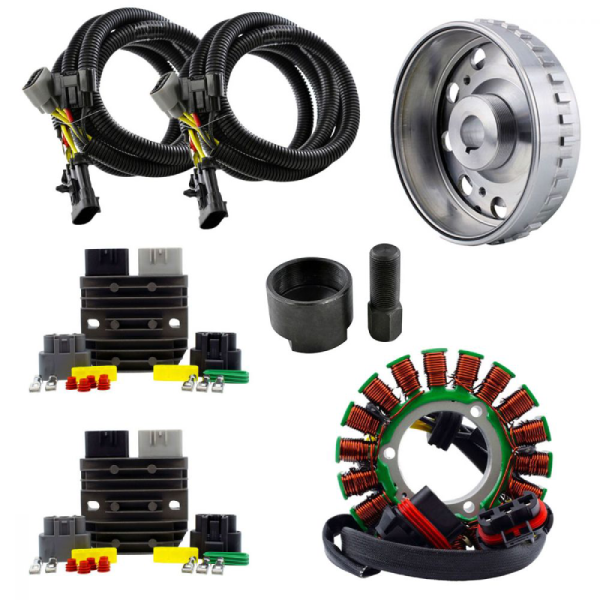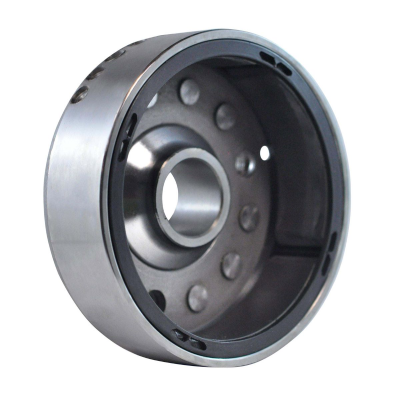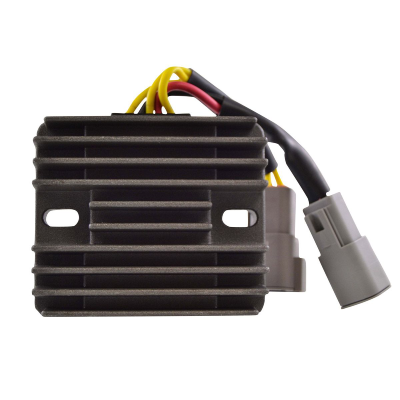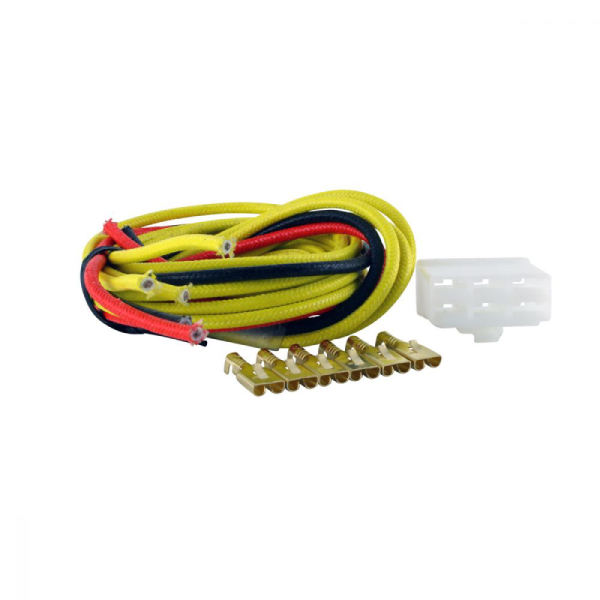Why use the SPLYT Technology?
As featured by Dirt Trax Television, RMSTATOR SPLYT Technology provides a reliable solution to well-known charging system failures. Using a dual output stator with two completely separate stator windings, this system splits the power generated by the stator into two separate voltage regulators. These regulators then each operate with only half of the load of the original system, allowing them to maintain a lower temperature and increase reliability.
This kit includes:
- Dual output stator
- Two SERIES voltage regulators
- Improved high output flywheel
- Two automotive grade relocation wiring harnesses with OEM-quality heavy-duty connectors
- Flywheel puller
- Gasket
- Complete instructions for voltage regulator relocation
Solve your Polaris RZR & Sportsman charging system issues today, once and for all, with RMSTATOR!
IMPORTANT NOTICE: This kit includes two wiring harness according to Polaris recal # Z-16-01-C (OEM # 2206620, 2206367,2206473). We strongly suggest you to relocate both of your regulators to make sure they do not wear out prematurely due to mud, dust or rocks.
All item pictures are accurate, matching exactly what you will receive.
Before installing your new stator
- Check the AC output of the stator
- Replace any burned or corroded connectors on stator and regulator rectifier
- Check and repair any melted wiring
- Use hi-temp dielectric grease on all connectors
Our stator may use a different wire color code than your original.
All the wires are installed in the correct order; please do not change any of the wiring configurations.
This stator is designed as a direct plug-in replacement and should be used as such.
When bolting stator in, always use locking compound.
If our stator includes a pickup coil, always make sure the air gap is correct upon installation; we suggest as close as possible no less than 0.010″.
Before installing your new SERIES Voltage Regulator Rectifier
- Check the AC output of the stator
- Replace any burned or corroded connectors on stator and regulator rectifier
- Check and repair any melted wiring
- Use hi-temp dielectric grease on all connectors
Before attempting to start your new Flywheel
adjusting the air gap is necessary. Rotate the flywheel so the raised node is lined up with the pick up/pulser coil and adjust as close as possible but no less than 0.010″.
Relocation Harness
- Plug-and-Play, direct fit
- Use hi-temp dielectric grease on all connectors.
Removing a Powersport Vehicle’s Flywheel / Rotor:
How it Works
Flywheel Pullers are very versatile engine service tools and are a must in every toolbox. Our large selection of best selling rotor and flywheel pullers fit just about any motorcycle or ATV. Flywheel pullers are very simple to use, having only an outer body to hold the flywheel and a screw to push on the crankshaft. Some are even simpler, having only a bolt to thread into the flywheel. A taper holds the flywheel or rotor and the crankshaft together. The flywheel is secured to the shaft by applying torque to the fixing bolt.
An Important Component to use
Many flywheel or rotor puller tools will include a small cap. This is a crankshaft thread protector, and should always be used if it is included with the puller. You slip this cap onto the end of the inner piece of the puller which presses against the tip of the crankshaft. This keeps the fine threads from being stripped or damaged while removing the flywheel or rotor.
Actions to Avoid
Most of the time, removing a flywheel or rotor is painless. But sometimes corrosion, over-torquing the fixing bolt or heat-cycling can give you a hard time removing the flywheel. We too often see mechanics use a larger breaker bar or air impact tools to ease the flywheel off. These two techniques will damage the flywheel, the flywheel puller or the crank. Avoid using them if you want to keep it cheap.
Tips to break a stuck flywheel loose:
Torque Wrench
How do you know if it’s stuck? You simply have to set your torque wrench to 50 ft-lbs and try to ease the flywheel off. If the flywheel is not stuck, you should be able to remove it with even less torque than this. If it is stuck, don’t use more torque or you might break your wrench.
Ball Peen Hammer
If 50 ft-lbs does not do the trick, go fetch something like a 12 or 16 oz ball peen hammer. Hit the end of the flywheel puller with a medium blow. Many times, the shock you create will successfully remove your flywheel. Be prepared to catch the flywheel since the shock of the hammer can make the flywheel jump off. Once again, getting into that situation will be pricey. And don’t forget your safety glasses.
Propane Torch
The hammer is not a be-all, end-all solution. Sometimes, you will have to find something more powerful, and that’s where the propane torch comes in. As a last resort solution, the heat should expand the flywheel but not the crank, since it is too massive to expand as fast. That way, the flywheel will become looser and will come off easier.
Important Security Tips: In order to not set fire to your garage, your vehicle or yourself, certain precautions are necessary prior to heating the flywheel:
- Clean any oil or flammable liquids off the flywheel;
- Make sure your work area is free of any flammable liquids and that you work in a well ventilated area;
- Make sure to remove the gas tank, and set it aside at a safe distance.
Make sure the flame of your torch is focused, and heat only the center of the flywheel. This is due to the fact that some flywheels use adhesive or other fixing compounds to locate the magnets in the rim that can be damaged by concentrated heat. Here again, the wheel might fall off the crank, so be prepared to catch it. And remember that you just heated it, so make sure you can catch it without burning yourself.
With these tips and techniques, you are now equipped to handle any stuck flywheel without throwing your flywheel puller at it; unless you have a habit of working with machines that have been in a lake for months!


















